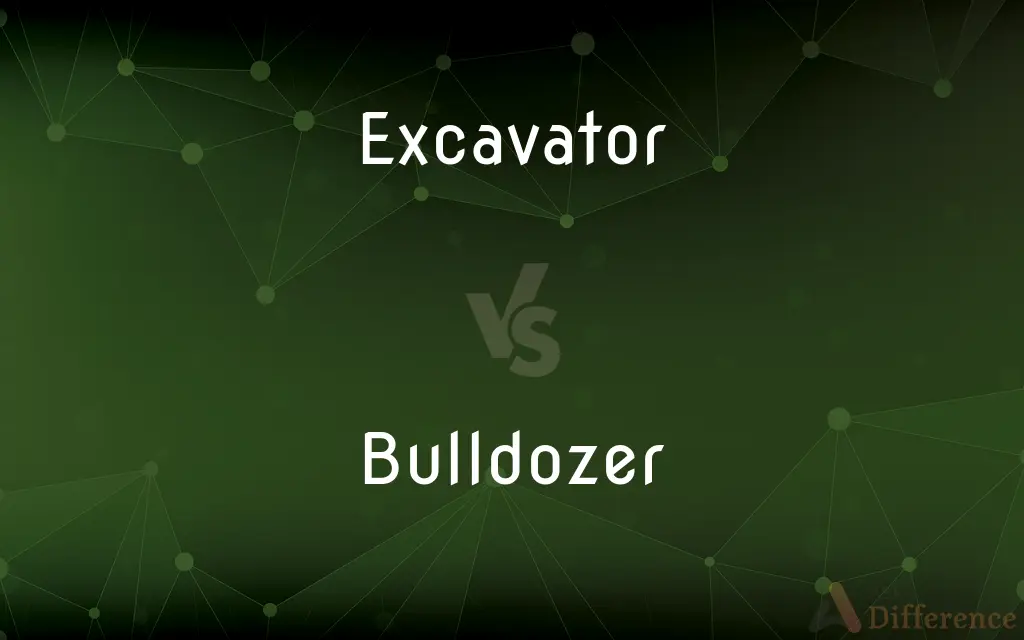Excavator vs. Bulldozer — What's the Difference?
By Maham Liaqat & Urooj Arif — Updated on April 23, 2024
An excavator is designed for digging and demolition, featuring a rotating cab and boom arm, while a bulldozer is built for pushing large quantities of material, equipped with a wide, flat blade at the front.

Difference Between Excavator and Bulldozer
Table of Contents
ADVERTISEMENT
Key Differences
Excavators are versatile construction vehicles characterized by a boom, stick, and bucket attached to a rotating platform known as the house. They are primarily used for digging trenches, holes, and foundations, as well as for demolition, heavy lifting, and dredging. The rotating cab provides a full range of motion, allowing for precise operation in various directions without needing to move the entire machine. On the other hand, bulldozers are powerful and heavy machines equipped with a large, flat blade at the front, designed for pushing, spreading, and moving large amounts of soil, sand, rubble, or other materials over short distances. Bulldozers feature tracks that provide stability and excellent ground holding capability, making them suitable for rough terrain.
Excavators are available in different sizes and configurations, such as mini-excavators for small-scale projects and confined spaces, and larger models for major construction tasks. They can be equipped with various attachments, like breakers and augers, enhancing their versatility. Bulldozers, while primarily known for their pushing power, can also be fitted with rear attachments, such as rippers, to break up hard ground. Their blade can be adjusted in height and angle, allowing for versatile operations like grading and backfilling.
The choice between an excavator and a bulldozer depends on the project's requirements. Excavators are ideal for jobs that require digging depth, precision, and versatility in attachment use. Bulldozers are preferred for tasks that involve moving large volumes of material, land clearing, and leveling. The capabilities of excavators to perform detailed excavation work and the strength of bulldozers to move substantial amounts of material efficiently illustrate the complementary roles these machines play in construction and land management.
In operation, excavators demonstrate their flexibility by rotating, which enables them to work in tight spaces and around various obstacles. This rotation capability is distinct from bulldozers, which have a fixed forward-facing orientation and rely on the movement of the entire machine to change direction. The efficiency of excavators in excavation and the bulldozer's effectiveness in pushing and grading operations show the specialized nature of each machine, tailored to specific construction and land management tasks.
Understanding the specific strengths and applications of excavators and bulldozers highlights the importance of selecting the right equipment for construction projects. Excavators offer precision and versatility, making them indispensable for excavation and demolition, while bulldozers provide unmatched power in moving and grading soil, playing a critical role in construction site preparation and land clearing efforts.
ADVERTISEMENT
Comparison Chart
Primary Function
Digging, demolition, heavy lifting, and dredging.
Pushing, spreading, and moving large amounts of material.
Key Features
Rotating cab, boom, stick, and bucket.
Wide, flat blade at the front; tracks for stability.
Versatility
High, with different sizes/configurations and attachments for various tasks.
Moderate, primarily for pushing material but can have rear attachments
Ideal Use
Trenches, holes, foundation work, and precision tasks.
Moving large volumes of material, land clearing, and leveling.
Mobility
Can rotate 360 degrees for work in tight spaces.
Moves in a straight line but excellent for rough terrain.
Operation
Precision in digging and demolition, flexibility in movement.
Powerful pushing capability, effective in grading and leveling.
Compare with Definitions
Excavator
A construction vehicle for digging and demolition with a rotating platform.
The construction team used an excavator to dig the building's foundation.
Bulldozer
Can be equipped with a ripper at the rear to break up hard soil.
To prepare the ground for landscaping, the bulldozer used its ripper to loosen the soil.
Excavator
Equipped with various attachments for different tasks.
For the demolition project, the excavator was fitted with a hydraulic breaker.
Bulldozer
Best suited for land clearing, road construction, and grading tasks.
For the new development, a bulldozer was used to grade the access road.
Excavator
Ideal for detailed excavation work and heavy lifting.
The team used an excavator to install large pipes in the trench.
Bulldozer
Efficient in moving large volumes of soil or rubble.
The bulldozer efficiently leveled the ground for the new parking lot.
Excavator
Characterized by its boom, stick, bucket, and rotating cab.
The excavator's rotating cab allowed it to load the truck without repositioning.
Bulldozer
Features tracks for stability and a blade that can be adjusted.
The bulldozer's tracks provided excellent traction on the uneven terrain.
Excavator
Known for its precision and ability to operate in tight spaces.
The excavator maneuvered around the confined site, removing debris.
Bulldozer
A heavy machine with a wide flat blade for pushing material.
The bulldozer cleared the site, pushing debris to one side.
Excavator
Excavators are heavy construction equipment consisting of a boom, dipper (or stick), bucket and cab on a rotating platform known as the "house". The house sits atop an undercarriage with tracks or wheels.
Bulldozer
A bulldozer or dozer (also called a crawler) is a large, motorized machine that travels on continuous tracks or large tires and is equipped with a metal blade to the front for pushing material: soil, sand, snow, rubble, or rock during construction or conversion work. When needed, a hook-like device (termed a ripper) can be mounted on the rear to loosen dense materials.
Excavator
A person who excavates an archaeological site.
Bulldozer
A powerful track-laying tractor with caterpillar tracks and a broad curved upright blade at the front for clearing ground.
Excavator
A large machine for digging and moving earth.
Bulldozer
A heavy, driver-operated machine for clearing and grading land, usually having continuous treads and a broad hydraulic blade in front.
Excavator
One that excavates, especially a machine used for digging having a bucket attached to a two-part boom and a rotating cab for the operator.
Bulldozer
An overbearing person; a bully.
Excavator
A person who excavates.
Bulldozer
A tractor with an attached blade for pushing earth and building debris for coarse preliminary surface grading, demolishing building structures, etc.
Excavator
A vehicle, often on tracks, used to dig ditches etc.Excavator
Bulldozer
One who bulldozes.
Excavator
A curette used to scrape out pathological material.
Bulldozer
A member of a self-identified group of white US Southerners who colluded to influence outcomes of post-Reconstruction elections by intimidating, coercing and bullying black voters and legislators, including burning down houses and churches, flogging and murdering opponents.
Excavator
One who, or that which, excavates or hollows out; a machine, as a dredging machine, or a tool, for excavating.
Bulldozer
(by extension) A bully; an overbearing individual.
Excavator
A workman who excavates for foundations of buildings or for quarrying
Bulldozer
To bulldoze (push through forcefully).
They bulldozered through the crowd.
Excavator
A machine for excavating
Bulldozer
One who bulldozes.
Common Curiosities
Can an excavator be used for tasks other than digging?
Yes, excavators can be used for a variety of tasks including demolition, heavy lifting, and dredging, thanks to their versatile attachments.
Why are bulldozers equipped with tracks?
Tracks provide bulldozers with stability and excellent traction, making them suitable for rough terrain and heavy pushing tasks.
How do excavators work in tight spaces?
Excavators have a rotating cab and boom arm that allow them to operate in tight spaces and around obstacles by rotating 360 degrees.
What considerations should be made when choosing between an excavator and a bulldozer for a project?
Considerations include the project's primary tasks (digging vs. moving material), the terrain, space constraints, and the specific functionalities required (precision work vs. bulk material handling).
What is the main difference between an excavator and a bulldozer?
The main difference is their primary function: excavators are designed for digging and precision work, while bulldozers are built to push large volumes of material.
What type of projects require a bulldozer?
Projects that involve moving large volumes of material, such as land clearing, road construction, and leveling, typically require a bulldozer.
Can the blades on bulldozers be adjusted?
Yes, the blades on bulldozers can be adjusted in height and angle, allowing them to be used for a variety of tasks including grading and backfilling.
Are there different types of excavators?
Yes, there are different types of excavators, including mini-excavators for small spaces and larger models for major construction work.
What makes an excavator versatile?
An excavator's versatility comes from its ability to rotate, its different size configurations, and the various attachments it can use for multiple tasks.
How does a bulldozer's ripper work?
A bulldozer's ripper is used to break up hard ground or soil, making it easier to move and manipulate with the blade.
Share Your Discovery

Previous Comparison
Grandpa vs. Granddad
Next Comparison
Deck vs. SundeckAuthor Spotlight
Written by
Maham LiaqatCo-written by
Urooj ArifUrooj is a skilled content writer at Ask Difference, known for her exceptional ability to simplify complex topics into engaging and informative content. With a passion for research and a flair for clear, concise writing, she consistently delivers articles that resonate with our diverse audience.














































